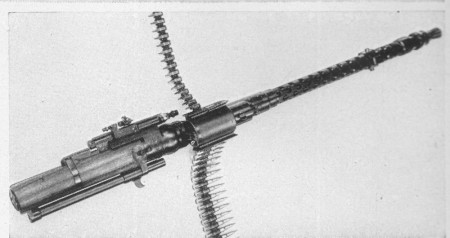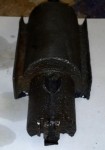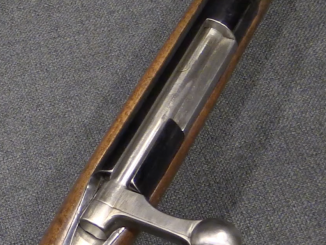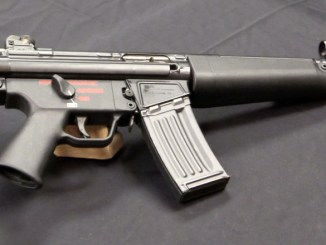The MG17 is one of the lesser-known German machine guns used in WWII, used for aircraft armament. Mechanically, the MG17 is basically the same as the MG15 ground gun, but with some aircraft-specific features like propeller synchronization, belt feed, pneumatic charging, and of course no grip or shoulder stock.

Developed at Solothurn and produced by Rheinmetall, the MG17 was intended for fixed mounts in aircraft, while the MG15 was used for manned flexible mountings. The MG17 was built more heavily (approximately 28 pounds unloaded with the necessary controls for remote operation) and fired at a higher cyclic rate of about 1200 rpm. Its belt feed was necessary for practical use, since fixed mounting points in the wings or nose of an aircraft could not be reloaded in flight.
One of the interesting details of the MG17 was its use of a hybrid open/closed bolt method of operation. The MG15 is strictly an open-bolt gun, and the designers wanted to retain the feature of having the bolt remain open when firing to improve cooling. So when the gun’s trigger is released, the bolt will be held in the open position. However, it does not use a fixed firing pin. In the MG15, the firing pin is cocked during forward travel of the bolt, and released immediately upon bolt locking. In the MG17 (when installed in synchronized mounts), the actual release of the firing pin was interrupted by an oscillating block timed to the propeller shaft. This meant that pulling the trigger would cause the bolt to chamber a round regardless of the propeller position, and if the prop was blocking the muzzle the gun would wait with the round chambered until the prop was clear, at which point the firing pin would strike and the firing sequence would resume.
The belt feed for the MG17 was made in the form of a detachable feed block, which was mounted to the gun’s receiver in the same position as the double drum on the MG15. We received an email from a reader who has gotten his hands on the belt-feed module from an MG17 that was installed on an Me-109 that crashed in Latvia, and spent quite a bit of time restoring it to functional condition. His goal is to adapt it to his registered MG15 machine gun, and we’re not sure how feasible that will be. The parts are heavily pitted from 70 years in the dirt, but he says everything appears to be intact and functional. If anyone know more about the specific differences between the MG15 and MG17 receivers, we (and Brent, who owns this piece) would appreciate any information!
He did send us a handful of photos showing the belt feed device, which are interesting to look at. The mechanism is based around a rotating spindle, similar to the Schwarzlose HMG. A ratchet in the front section was used to rotate the spindle at the appropriate times to feed new cartridges. The belt used for these guns was the Gurt 17/81 – the same as used in the MG81, and slightly different from the belts used by the MG34 and MG42 ground guns.










All together now, [insert sound of a Messerschmitt Bf-109 E-1 firing its four MG17s into a Hawker Hurricane]…
Great, we’ve solved the bullets per minute issue. Now how about that ammunition? The Luftwaffe needed really high quality ammo, and from what I know, the K-bullets developed during World War I didn’t get used up in the atmosphere, heavy armor plating being absent from most aircraft. I also assume that the lack of penetration power of rifle-caliber bullets (and even heavy machine gun bullets) is what drove the European, Soviet, and Japanese to get autocannons in their planes.
This is a common fallacy that the .50 Caliber did not have sufficient penetration. Cannon shells have less penetration than RCMGs!(Rifle Caliber Machine Guns) In that when the shell strikes the plane’s skin, it explodes and about half the fragments go into the plane and the other half are wasted in thin air. The typical Hisso shell breaks into 10-12 large fragments, none, to one of which can damage any significant structure in side the plane. An average 20 mm shell striking the engine cowling and exploding will not damage the engine block, heads, valve covers, intake manifold, supercharger case, or carburetor-fuel dispersion system. The only parts that it can easily damage are the spark plug wires, fuel and coolant lines, or engine control wires, if it has them. On the other hand, a RCMG Bullet will certainly damage any of those parts struck at under 3-400 Meters.
Now the problem with RCMGs is that a 1/4″ armor plate provides complete protection from damage, or injury to the pilot. Buy the way, a fragment from a 20 mm shell will not injure the pilot unless the shell entered the cockpit on a trajectory that would have done the same damage as a RCMG bullet! IE, at very close range a RCMG AP bullet will perforate the armor plate under ideal conditions, but no fragment of a 20 mm shell will do so under any conditions. So either projectile would have had to miss the armor and hit the pilot from the side, or fail to do significant damage.
Now on to the .50 Caliber weapon. The thickest armor on any WW-II plane was on the front to stop the defensive guns on American bombers from downing the fighter before it could damage or destroy the bomber. It varied from 10-12 MM thick in the fire wall above the engine on Fw-190s. The engine was considered more than enough protection to save the pilot until he had destroyed the bomber.
Does anyone here think 10-12 mm of cheap steel armor will stop a .50 caliber Mk-8 AP bullet? Do a Google search. German seat back armor was only 8-9 mm thick.
Thanks for clearing it up, but try doing the above in a swirling dogfight where most of your bullets actually deflect off your opponent’s aircraft since no sane pilot wishes to present his machine as a target with a surface normal to your guns! And not all 20 mm shells explode on the surface. Some are intended to penetrate first and then detonate, right?
MG 17 was developed in early 1930s when airplanes were mainly wood with fabric cover so the rifle rounds was sufficient to aircraft use.
BTW I think that designers (and users) of 1930s aircraft MG have rate-of-fire-mania. For example Soviets developed many aircraft MG with rate of fire bigger than ShKAS (1800rpm) but none of them enter mass production (names of these MG: UltraShKAS, SIBEMAS, SN=Savin-Norov, Yurchenko machine gun / respectively in Russian letters: УльтраШКАС, СИБЕМАС, СН, Юрченко)
Rate of fire is a legitimate requirement for AA and aircraft weapons because target alignment tends to be momentary or fleeting. One characteristic of aircraft being that they move in three dimensions! The tradeoff of a high rate of fire is that you only get a few bursts before you’re dry-firing in a firefight, always a bad feeling.
2 rifle-caliber MGs was stanadard armament from circa 1916 in the Great War to the opening of WWII. In 1935, British wanted a plane that could really chew up bombers so they specified 8 rifle-caliber MGs. Many of their bombers’ defensive guns were rifle-caliber, too (the Lancaster had 4 .303 Brownings in a turret, and it was introduced midwar. There was a field mod to change it to twin .50s).
The Germans were among the first to go heavier with hub-firing 20mm on the Emil (Bf109E), and the Brits soon were jamming 20mm in their fighters, and even 40mm on Hurricanes for ground attack (tank busting). The Germans replaced many MG17s with 13mm and 20mm weapons.
The US had started to put cannon in AC before WWII with a view to ground attack and, especially, attacking bomber formations. The US entry to war found us with four different air-to-air calibers: .30, .50, 20mm, and 37mm. (The 37 required the plane to be designed around it, the Bell P-39 Airacobra). The US decided to standardize on the .50 and give the planes with rifle-caliber guns and big cannon to our allies through Lend-Lease. The planes with the big Oldsmobile 37mm mostly went to Russia, and Russian pilots did way better with the type than Americans ever did.
The P-47 had eight .50s, but it was designed for air to air only and had no provisions for ground attack — these were improvised in the field and it became a great fighter-bomber.
There was always a question of where you “synchronized” your guns, meaning, at which range you wanted the cone of fire of your various guns to converge. This was greatly complicated when you had multiple guns firing different, ballistically incompatible calibers. Many aces got that way by closing to point-blank range to be sure of their target.
“air-to-air calibers(…)and 37mm.”
The 37mm Cannon M4 was rather poor air-to-air weapon, muzzle velocity was low (hence long bullet travel time) and rate of fire was low (only 150rpm) so far I know the first aircraft to use 37mm M4 was Bell YFM-1 Airacuda which was designed as a “bomber-buster” but in Airacuda each 37mm has gunner. More about YFM-1:
http://en.wikipedia.org/wiki/Bell_YFM-1_Airacuda
“US entry to war(…)20mm”
The American 20mm Hispano-Suiza from early production have serious flaws and don’t work reliable.
http://en.wikipedia.org/wiki/Hispano-Suiza_HS.404#US_production states that:
“The problems of the American weapons led to most US fighters being equipped with the AN/M2 .50 cal Browning light-barrel HMG throughout the war.”
Rate of fire is easily the single most important factor in determining the effectiveness of an A2A gun. Other factors such as MV and BC are also important, but once the threshold energy at the target is reached, only rate of fire is important.
Early in WW-II, RCMGs were perfectly fine for A2A work. But as soon as they started to armor the vital areas of the target, they became less and less important.
The Americans, who were the only Nation to spend any real money studying the results of WW-II Air Combat, and the Russians who’s spies stole the results, both built very high rate of fire guns, because they knew it was important. We found out after further tests that MV was also very important, with BC less important. The second two factors determined to a very large extent how easy it was to hit your target. This is where we wised up and cracked down on Ruski spying. They used guns that fired larger shells at lower velocities while we used smaller shells at higher velocities. We found that MV was so important that we spent billions, not millions, or tens of thousands as did the rest of the allies, to make ever higher MV/BC ammunition for our aircraft guns. Read the history of the Ford/Philco Telescoped Case 25 MM Gatling gun to see how important this was. When that was determined to be two expensive for our Chickenshit politicians, they cancelled that and reverted to a very long barreled version of the Vulcan Gatling gun from the early 1950s! They upped the rate of fire and reduced the weight of the shell to only 84 grams, making it much more pointed and used propellant based on moderated RDX to get a MV of 1,525 M/S!!!!
Between the reduced ToF to the target and increased RoF, we concluded that it was between four and five times as effective as the gun in the F-14/15/16/18, which was considered two to four times as effective as any other gun(s) installation in the sky.
Read an amusing account of how the British figured out where to put the armor plating on their aircraft: the looked for bullet holes on returning air craft, and put the armor plate elsewhere. If a plane never made it back with a bullet hole in a certain place, that was the place to armor.
This appears to be a ‘cartridge stripper’ type feed which snaps cartridges out of the belt through the gap in the ‘C’ shaped metal belt link stamping, ‘perpendicular & down’ to the belt travel path. [Most German LMGs stripped cartridges ‘perpendicular & forward’ to the belt travel path.]
GE used the same system feeding the M61 GAU-4 20mm delinker and Dillon Aero does the same in the M134 GAU 2B/A Minigun delinker. Wonder whether they borrowed this idea from Solothurn or were there other designs which preceeded it?
View identified as ‘Underside’ might be better captioned as ‘Gun Side’ in American ordnance parlance. Top side would be ‘outside’. Feed ratchet is called a ‘delinker spool’ in American parlance.
There should be some stripping fingers to guide the cartridges out of the belt. Probably lost to corrosion and pretty hard to duplicate without an image or engineering drawing.
The entire argument of which was the best A2A weapon in WW-II is clouded by the defects and superiorities of the planes they were mounted in. Like the fact that the Bell P-39 was arguably the best A2A fighter on the Allied side, because the Ruskies shot down more Germans with it than any American or British pilot did with any other allied plane, except the B-17. Not to mention the fact that about 400 Nazi Pilots shot down more allied planes than the entire allied fighter types combined with Me-109s.
That in itself is a conundrum for the ages! Then we have the wing VS Fuselage mounting of guns controversy. As others have mentioned here, there is a huge argument about which is better because none of the wing mounted guns fans listen to the top aces on both sides. Fuselage guns are very much better and much more effective than wing mounted guns. Not that either type can be made to work, just that one is demonstrably better than the other.
Having said that, I would point out that the 37 MM cannon in the P-39 had the Highest MV and BC of all major A2A large bore cannon of the war. ( Necessarily discounting the Mk-101/103 which were mostly used for tank busting!) The most numerous large bore cannon on the other hand had the lowest MV and BC of ALL guns in the war. But the Germans thought it was better than the rest in spite of it? What makes one better than the other then? About the typical cannon of WW-II, the 20 mm, there were a dozen types, but only two stand out. the Best based on stats, the Hisso 20 fired a blunt nosed, 130 gram shell at 840 M/S while the second best shot an almost as blunt, 109 gram shell at 705 M/S. Rates of fire were similar at ~600 and >750 Shots per minute. So what made one stand out enough so that it is still in production and the other is long gone? I think two things made the difference at the time. The less powerful gun had a faster rate of fire with a more effective shell AND was mounted on the engine, shooting down the plane’s CL and the pilot’s LOS. It was also mounted in the most effective fighter weapon system of the war, which helps.
The difference as installed during the war was that the weaker gun had about five times the “EFFECTIVE” Range as the stronger gun because of the way it was mounted.
Guns on the CL fire down the line of sight, while guns mounted out in the wings fire away from the pilot’s LOS, except at a very short range where they are “Harmonized”, or “Zeroed” to cross the pilot’s LOS at some range in front of the plane.
To make this point even clearer, the wing mounted guns trajectory starts 7-8′ out in the wing and 40-48″ below the LOS through the gun sight, rises up and come in until it crosses the LOS through the sight at 200-250 yards range and then continues up and away on the other side of the LOS. If the Target is 36″ to one meter wide, then the two bullet streams will be hitting the target for only 64-88 yards, half before and half after the Zero Range, even when the target is perfectly centered in the gun sight!
But when the German Me-109 pilot sights his target at any range between contact and 6-800 Meters, all the bullets/shells will hit.
This simple fact makes it infinitely, nor really, but very much at least, easier to get hits with CL mounted guns than wing mounted guns.
The P-38 had the guns in the nose, not the wings. I’ve wondered before if that helped them hit Yamamoto’s plane at a long firing distance.
Regarding the whole cannon vs machine gun issue, I think one has to look at the missions of the Allies versus the Nazi’s as time went on: Allied fighters needed to shoot down other fighters to protect the bombers, and a shot gun high-rate-of-fire in a dog fight was their strategy against a single engine, single pilot craft. The Germans wanted to defend against bombers that were flying in formation, and that for a good long time had no fighter escort into Germany. A B-17 with four engines and multiple crew men could take a lot of machine gun fire and still fly, bomb, and come back the next day. Start lobbing cannon fire into a B-17 and it would not. My understanding was that the German pilots would essentially use their machine guns to spot where the cannon fire would go.
“I would point out that the 37 MM cannon in the P-39 had the Highest MV and BC of all major A2A large bore cannon of the war. ( Necessarily discounting the Mk-101/103 which were mostly used for tank busting!)”
You forgot about soviet NS-37 with MV 900m/s and was used in both air-to-air and air-to-ground role.
This gun, given the corrosion damage present, has hardly any chance to be ‘functional’, be it just dry-firing only. I’d suggest to turn it into art piece. It looks good as is.
To those who are interested on history of WWII armament development – http://www.quarry.nildram.co.uk/WW2guneffect.htm
It is evident that the barrelled type arms came to their peak thru that period. For footnote might be good to say this: auto-cannons were never completely written off. I had conversation with SA Air-force pilot last Fall who told me about effectiveness of quadruple ZSU-23 Shilka(with radar). One of his buddies lost his life to tis thing over Angola; and of course they were flying supersonic Mirages. They feared that like devil fears the cross.
BTW, closer to the subject – here are pictures of nearly immaculate MG15.
http://www.deactivated-guns.co.uk/detail/mg15_2.htm
I always admired slick and elegant design of this recoil operated MG. Of course, his bigger brother has more devices hooked up on it and get more cumbersome. Still, those on receiving side had certainly respect for them.
If I remember correctly, the Japanese Imperial Army Air Force used a few MG17s, along with Vickers fixed and flexible guns. The Imperial Japanese Navy also used their copy of the Lewis gun (Imperial Japanese Navy)
They were models 97 (Vickers) and 99, later it was mostly Ho5 (copy of .50cal Browning).
http://en.wikipedia.org/wiki/Type_97_aircraft_machine_gun
The belt feed, for the MG17, wasdeveloped by Hans Schmeisser, the brother of Hugo Schmeisser and second son of Luis Schmeisser, it uses zerfallgurtt that later was used in the MG 81This mecanism useda bigger force than the magasin feed, witch was deliverd by a new mussle trap, developed atSchults &Larsen in Otterup
Talking about 20mm Cannon shells, both Hispano and Oerlikon Cannon ammo included “Solid Shot” ( no explosive, maybe only Tracer in Base)…this certainly did penetrate Aircraft Bodies , Engines, etc, and was also used for Ground Strafing ( Locomotives, etc) where the Boiler Plating was substantially stronger than Aircraft Plating… It was not uncommon in 1944-45 to have German and Italian Steam Locomotives fail on the Tracks due to multiple 20mm Holes in their Boilers from a Strafing run (Typhoons or P38 Lightnings.)
Doc AV